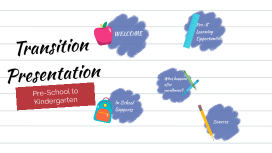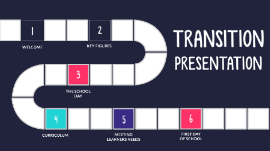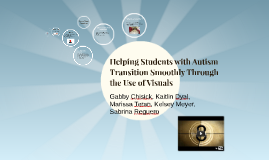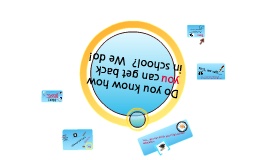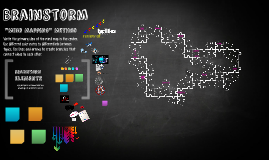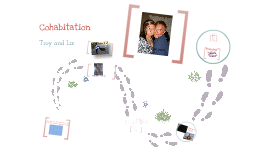Transition Presentation
Transcript: Transition Presentation Pre-School to Kindergarten Entering Kindergarten WELCOME Intake Plans Children usually start Kindergarten when they turn five however parents can delay enrollment for the following school year. Often attendance is not full time (ACT, 2016) Plans for intake According to the "Special Education Services: A Manual of Policies, Procedures and Guidelines students with ASD are eligible for full time enrollment, the implementation of an IEP, and coordination of entry to school. School districts may elect to contract services from an early childhood center for a portion of the kindergarten year. (Special Education Services, 2016) Many children have been diagnosed with Autism before entering school Plans continued... Intake Plans Contact your districts Special Education Department at least 6 months prior to the start of school (ACT, 2016) Bring all records, including Autism diagnosis to the first meeting (ACT, 2016) If the child is registered in a preschool program, the principal may send a school personnel from the SBT to visit the preschool, typically the resource teacher, to observe the child and see the child in a group setting (ACT, 2016) Awaiting an Assessment? The school should still be notified and be made aware of their needs for planning purposes. (ACT, 2016) Following the preschool observation resource team meets with SBT to organize proper placement for the student. Pre-K Learning Opportunities Pre-K Learning Opportunities Service Providers The Autism Quick Start Guide is a wonderful , practical tool : https://www2.gov.bc.ca/assets/gov/health/managing-your-health/autism/autism_quick_start_guide_ages_0-5.pdf 1 Schedule a meeting with Children and Youth with Special Needs Worker 2 RASP Service Providers 3 Parents are responsible for hiring service providers from the Registered Autism Service Providers List. (Ministry of Children and Family Development, 2018) Early Interventions 4 General Types of RASP Providers: 4 Occupational Therapy, Speech Language Pathologist, Physical Therapist, Behaviour Analyst (Ministry of Children and Family Development, 2018) Under 6? 5 Families can access up to $22,000 to pay for services (Ministry of Children and Family Development, 2018) Programs Some Pre-School Learning Opportunities BC Center for Ability: Stepping Stones Ready Set Learn Allows families to participate in bi-monthly family nights. Strong Start (British Columbia, n.d.) Families attend at a local elementary school and the intention is to support transitions to school Play based learning activities for ages 0-5 Parents also have the opportunity to participate in training and education around their childs social emotional wellness. No cost to families and participate on a drop-in basis Fostering positive connections between families, school system, and local agencies (British Columbia, n.d.) There are also KIndergarten transition workshops. I attended one for my son through this program. 329 Strong Start Programs across British Columbia Intended for children aged 3-5 Participate with your child Self-regulation strategies and social awareness are important (BC Center for Ability, n.d.) Get tips to encourage lifelong learners and include: talking, feelings, play, getting along with others, healthy food options (British Columbia, n.d.) What happens after enrollment? What happens after enrollment? -The child is placed in a classroom. -It is important to build a successful partnership and connection between home and school -The family comes to tour the school. -Social Stories/Narratives are used prior to entry (Bodine, 2020) -Student typically has a gradual entry program Preparation Strategies for preparation - Entering Kindergarten Provide a map of the school, classroom or video for student to watch at home with their parents Social Stories/Narratives can be effectively used to assist with the transition. Find some here: Parents can create a calendar of counting down the days until the transition from summer holidays and should take about the transition well in advance (ErinOAKids, 2012) https://www.pbisworld.com/tier-2/social-stories/ Establish a transition team including parents, outside therapists, teacher, principal (Educator Support Guide for Transition Planning, n.d) https://www.abaresources.com/social-stories/ https://www.autismlittlelearners.com/2020/06/transitioning-to-new-school-stories.html?fbclid=IwAR1UyssPJROQCmBzNk0Xb5w9cASEG6PIOSDs6yQ8uL7t4SMNwA2HTmv9hIk In School Supports In School Supports IEP Individual Education Plan An IEP is created as a plan to address individual needs, goals, adaptations which is reviewed at least once a year. (ACT, 2016) The case manager (usually a resource teacher) is responsible for the coordination of the IEP. The case manager will speak with the parents about the individual needs and loop in other members of the SBT if necessary. This should be done before the start of the school year, typically in the Spring. (ACT, 2016) SBT School Based Team (SBT)






